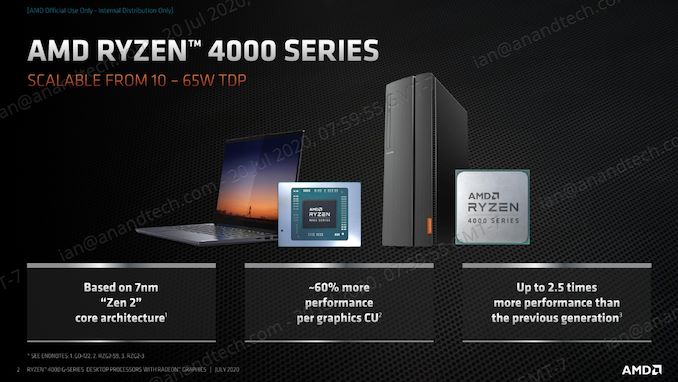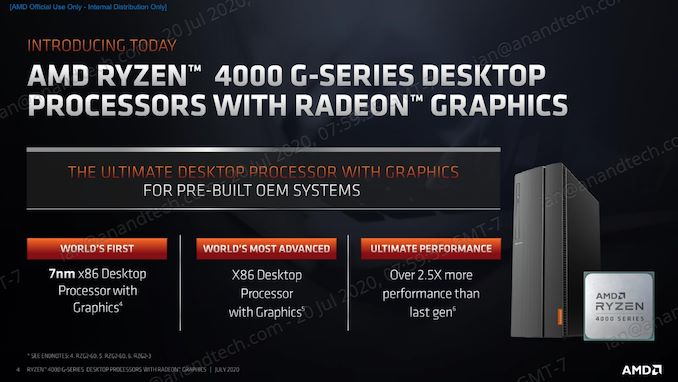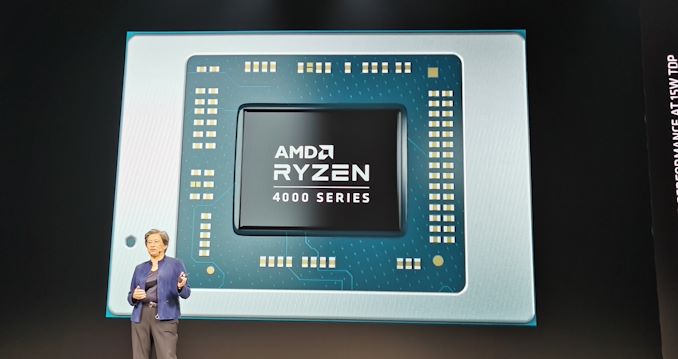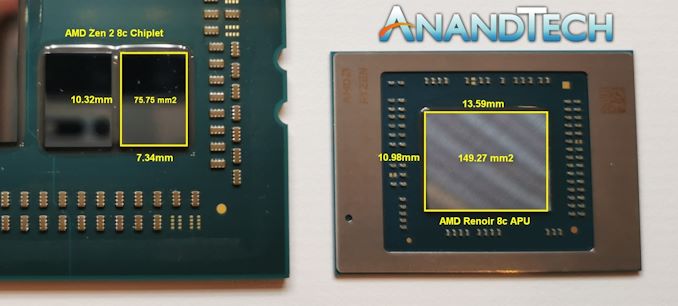AMD Launches 12 Desktop Renoir Ryzen 4000G Series APUs: But You Can’t Buy Them
by Dr. Ian Cutress on July 21, 2020 9:00 AM EST
Today AMD is finally lifting the lid on its long-awaited desktop Zen2 based APU family. Using the same silicon as in the Ryzen Mobile 4000 family, AMD is pumping it up into 35 W and 65 models in the same AM4 platform that is in use today. There has been strong demand from PC builders to release these chips, which were on the topics of forum conversation all the way back at CES. There’s only one downside to these new processors: you can’t buy them on their own. AMD states that the initial release of Ryzen 4000G hardware is for OEMs like Dell and HP only for their pre-built systems.
The new processors use the same 8-core Zen2 plus 8 compute unit Vega that we saw in Ryzen Mobile 4000 at the beginning of the year, but as with previous APU launches, the frequency and power thermals have been pushed up into more manageable desktop environments. To that end, AMD will be launching hardware in the Ryzen 7, Ryzen 5, and Ryzen 3 product lines at both 65 W and 35 W, all on the AM4 platform.
| AMD Ryzen 4000G Series APUs | |||||||
| AnandTech | C/T | Base Freq |
Turbo Freq |
GPU CUs |
GPU Freq |
PCIe * |
TDP |
| Ryzen 4000G | |||||||
| Ryzen 7 4700G | 8 / 16 | 3600 | 4400 | 8 | 2100 | 16+4+4 | 65 W |
| Ryzen 7 4700GE | 8 / 16 | 3100 | 4300 | 8 | 2000 | 16+4+4 | 35 W |
| Ryzen 5 4600G | 6 / 12 | 3700 | 4200 | 7 | 1900 | 16+4+4 | 65 W |
| Ryzen 5 4600GE | 6 / 12 | 3300 | 4200 | 7 | 1900 | 16+4+4 | 35 W |
| Ryzen 3 4300G | 4 / 8 | 3800 | 4000 | 6 | 1700 | 16+4+4 | 65 W |
| Ryzen 3 4300GE | 4 / 8 | 3500 | 4000 | 6 | 1700 | 16+4+4 | 35 W |
| Ryzen Pro 4000G | |||||||
| Ryzen 7 Pro 4700G | 8 / 16 | 3600 | 4400 | 8 | 2100 | 16+4+4 | 65 W |
| Ryzen 7 Pro 4750GE | 8 / 16 | 3100 | 4300 | 8 | 2000 | 16+4+4 | 35 W |
| Ryzen 5 Pro 4650G | 6 / 12 | 3700 | 4200 | 7 | 1900 | 16+4+4 | 65 W |
| Ryzen 5 Pro 4650GE | 6 / 12 | 3300 | 4200 | 7 | 1900 | 16+4+4 | 35 W |
| Ryzen 3 Pro 4350G | 4 / 8 | 3800 | 4000 | 6 | 1700 | 16+4+4 | 65 W |
| Ryzen 3 Pro 4350GE | 4 / 8 | 3500 | 4000 | 6 | 1700 | 16+4+4 | 35 W |
| *PCIe lanes on the SoC are listed in GFX+Chipset+Storage | |||||||
The top processor is the Ryzen 7 4700G, coming in at 65 W TDP with a base frequency of 3.6 GHz and a turbo frequency of 4.4 GHz. It uses all eight compute units for the graphics, running at a mind-numbing 2100 MHz.
At the lower end is the Ryzen 3 4300G, with four cores and eight threads, with a base of 3.8 GHz and a turbo of 4.0 GHz, which should mean that performance is very consistent. This part has six compute units for graphics, running at 1700 MHz.
Every version has a GE counterpart at 35 W, which for the most part reduces the base frequency and TDP only. The exception is the Ryzen 7, where 100 MHz is lost on turbo and 100 MHz is lost on graphics.
All the APUs support DDR4-3200, and have sixteen PCIe 3.0 lanes for add-in cards, as well as four PCIe 3.0 lanes for storage. On the PCIe lanes, the reason this is PCIe 3.0 and not PCIe 4.0 is because the equivalent mobile chip was built with eight PCIe 3.0 lanes for add-in cards, to save on power in a mobile environment. AMD sees these chips being used mostly on their own without a separate discrete graphics card, given that the company already has the Ryzen 3 CPU family for those that want discrete graphics.
At the same time as the Ryzen 4000G APUs, AMD is also launching the Ryzen Pro 4000G versions for the commercial market. These specifications mirror the standard Ryzen counterparts, but fall under AMD’s Pro Technologies feature set, with additional security, manageability, and business ready pillars. This includes full memory encryption and support for DASH management, OS image stability over 18 months, guaranteed processor availability for 24 months, and enhanced QA.
So they are OEM only? What?
Just to be clear, AMD specified OEM and not system integrators (SIs). On our call, AMD clarified that the market for its APUs is skewed very heavily towards the big mass-market prebuilt customers like HP and Dell, rather than custom home builds. The numbers quoted were around 80% of all APU sales end up in these systems, and by working with OEMs only, AMD can also help manage stock levels of the Renoir silicon coming out of the fabs between desktops and notebooks.
What this means is that unless you are choosing to buy a pre-built office-focused business PC, then the only way to get hold of these processors would be through distributors who are selling them piecemeal – AMD is not creating official boxes and bundles with coolers for these processors.
Those pre-built office-focused business PCs are expected to be out shortly. Just in case you control a corporate budget and need a few hundred of them.
Will we ever get Ryzen 4000 APUs for Desktop?
AMD says that they are planning a consumer-grade release of APUs ‘soon’. It was stated in our briefing call that there will be a launch of a future Zen2 APU for the consumer market compatible with 500-series motherboards. The company specifically did not say 400-series, but did clarify that the 4000G series announced today was for 400 and 500 series.
When exactly this launch will come, and what it will be, and what price ranges AMD will be aiming for is unclear. As mentioned, we were discussing Zen 2 based Renoir desktop APUs with vendors back in January, and at this point it certainly feels late to the game. Could AMD be hiding something up its sleeve? A PCIe 4.0 version perhaps (would this require new silicon?) or maybe something up at the 105 W TDP performance level? It really is unclear.
There’s also some new Zen+ APUs
For the lower end of the prebuilt market, AMD is also offering a new set of Zen+ APUs. These are the first desktop parts to carry the Athlon Gold and Athlon Silver branding.
| AMD Athlon 3000G Series | |||||||
| AnandTech | C/T | Base Freq |
Turbo Freq |
GPU CUs |
GPU Freq |
PCIe * |
TDP |
| Athlon 3000G | |||||||
| Athlon Gold 3150G | 4 / 4 | ? | 3900 | 3 | 1100 | 8+4+4 | 65 W |
| Athlon Gold 3150GE | 4 / 4 | ? | 3800 | 3 | 1100 | 8+4+4 | 35 W |
| Athlon Silver 3050GE | 2 / 4 | 3400 | - | 3 | 1100 | 4+2+2 | 35 W |
| Athlon Pro 3000G | |||||||
| Athlon Gold Pro 3150G | 4 / 4 | 3500 | 3900 | 3 | 1100 | 8+4+4 | 65 W |
| Athlon Gold Pro 3150GE | 4 / 4 | 3300 | 3800 | 3 | 1100 | 8+4+4 | 35 W |
| Athlon Silver Pro 3125GE | 2 / 4 | 3400 | - | 3 | 1100 | 4+2+2 | 35 W |
| PCIe lanes on the SoC are listed as GFX+Chipset+Storage | |||||||
We believe these to be based on the same silicon as the Athlon Gold and Athlon Silver mobile parts. We're still waiting on full details for the 3000G family.
The Final Word: We were told that there will be a reviewers’ guide shared with us. Whether that is for these OEM-only parts, or for something upcoming, we don’t know. But we have our fingers crossed.















130 Comments
View All Comments
Spunjji - Wednesday, July 22, 2020 - link
As best I can tell, that's highly likely to depend on the specific board. AMD don't seem to be guaranteeing support on anything but B5XX, but we've seen a bunch of their CPUs supported "unofficially" on other boards before. I'd be surprised if this were an exception, but I certainly wouldn't bank on it being supported either.desii - Tuesday, July 21, 2020 - link
FWIW, the Pro lineup is showing up in some stores in Europe.danjw - Tuesday, July 21, 2020 - link
I guess the thing that really rubs me the wrong way here, is that they should have let people know earlier that these were intended as only OEM parts. They have been stringing people along for over 6 months, since CES.Qasar - Wednesday, July 22, 2020 - link
these apus for the OEMs, yes. other APUs for the consumer market, are forth coming, says so right in the article.Spunjji - Wednesday, July 22, 2020 - link
The only launched the mobile parts at CES:https://www.anandtech.com/show/15324/amd-ryzen-400...
News about the OEM limitation on the desktop APUs has been circulating for a while now:
https://www.hardwaretimes.com/amd-renoir-desktop-a...
I don't think they ever intended them only for OEMs - they're just facing up to market realities.
You don't get endless crying about stuff that was never promised on Intel articles. I wonder why...
hubick - Tuesday, July 21, 2020 - link
I stopped reading at OEM only. OEM's are horrible. Get your local computer store to build you a system, so they can fix it in days instead of months.kourosh daryaei - Tuesday, July 21, 2020 - link
garaunty cpu get back and replace might have been mind in oem mode or cannot buy since new is corrected old cpu ryzen 7 or ryzen 5 or ryzen 3 are cpu geo-processing field optimization by per process freqency transistor transaction factor from endless to 1 to 3/2 or 5/3 or attunement technich like ryzen 4000 new designzamroni - Tuesday, July 21, 2020 - link
It's reasonable to make them oem only.Most consumer desktop users put gpu in their system as $150 gtx 1650 is more powerful than any integrated gpu.
supdawgwtfd - Wednesday, July 22, 2020 - link
Citation needed lol."most" Consumer desktop users do NOT have a discrete GPU at all!
You are delusion if you think the majority do.
Gigaplex - Friday, July 24, 2020 - link
I think they meant non-OEM systems, or "consumer built".